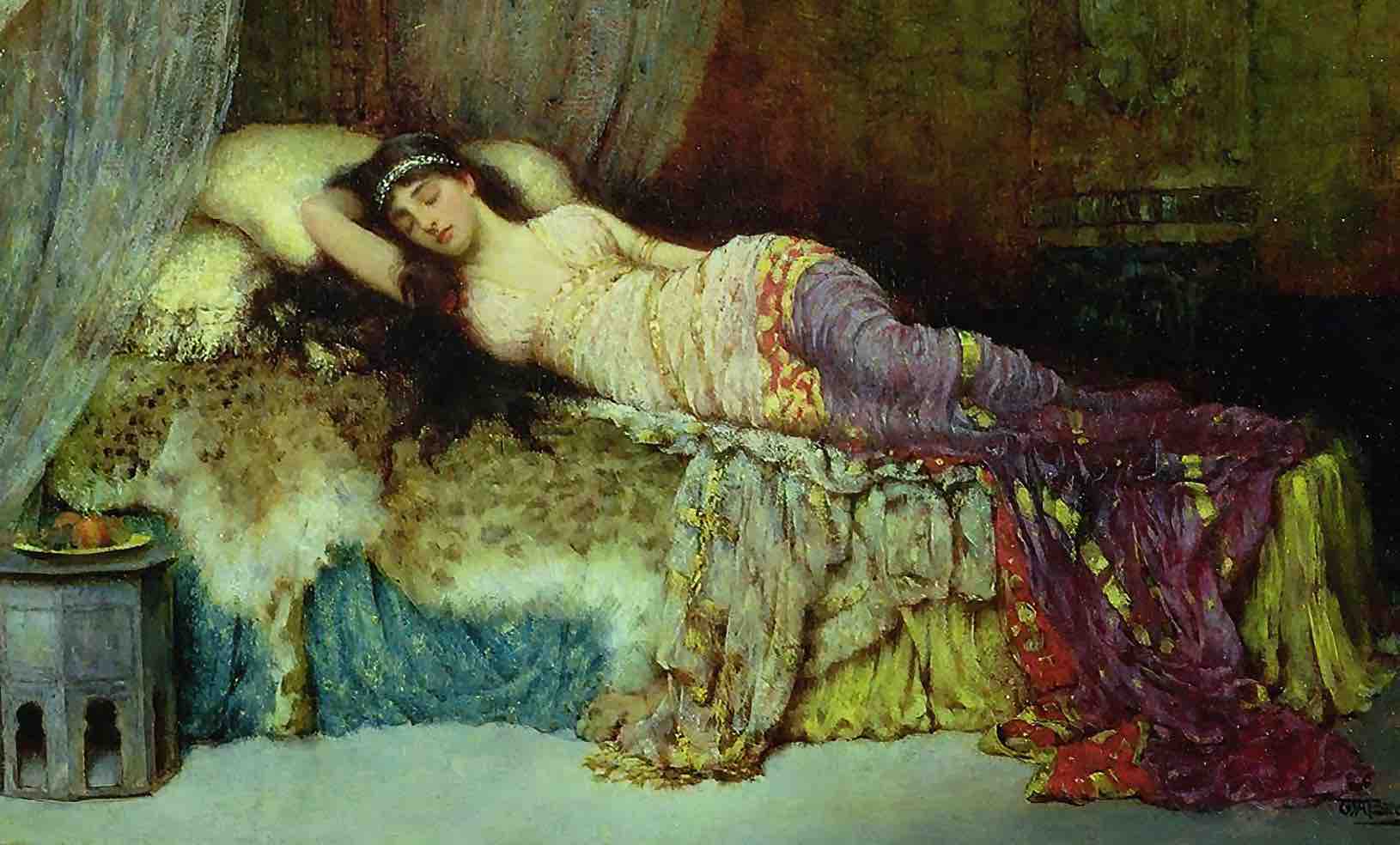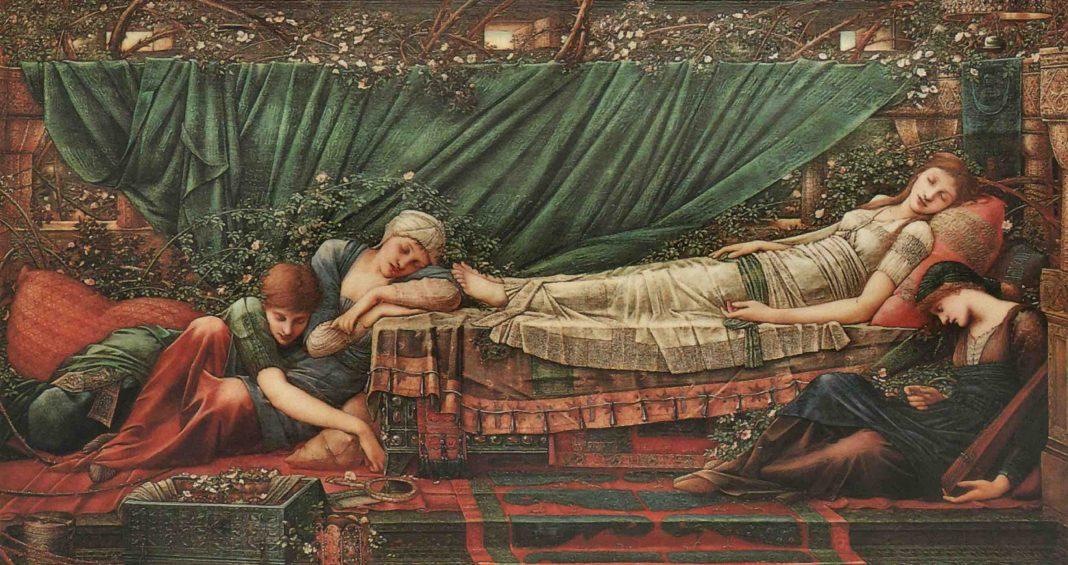Feature: The Rose Bower (1885 –1890), by Edward Burne-Jones
Artmedia / Alamy Stock Photo
In the dining room of Buscot Park, in Oxfordshire, England, a beautiful young princess sleeps, surrounded by her court. Before you think I am making some claims that England is a place of fairy tales, I am referring to Edward Burne-Jones’s Briar Rose sequence. Each wall holds a massive canvas telling the story of Sleeping Beauty, filling the room with dozing guards, snoozing ladies in waiting, and snoring courtiers, alongside the wan figure of Sleeping Beauty, who has slept there for more than 130 years. The whole court will remain in eternal pictorial slumber, until a future owner decides Pre-Raphaelite wall friezes are not their cup of tea and consigns the panels to the attic.
For Edward Burne-Jones, the thought of his daughter Margaret, the model for his slumbering princess, sleeping forever in a hidden attic room might have been a blessed relief.
I don’t think it’s any coincidence that he chose his daughter as the model for this fairy-tale princess. The artist famously had issues with his daughter growing up and becoming a woman. He maintained a state of nervous collapse in the weeks before her marriage in 1888, in the midst of his work on the Briar Rose sequence, which lasted from 1885 to 1890.
It wasn’t just his daughter that Burne-Jones bewailed in their adulthood; it was all her friends as well. In 1880, he painted a bevy of them gaily tripping down The Golden Stairs. The accomplished young ladies noisily descend into womanhood, a journey that the artist seemed to regret. In girlhood, there is innocence and wonder, the notion that fairy tales could be true. In adulthood, there is danger, loss, and life from which girls should be protected.
Mind you, given the growth and popularity of postmortem photography during the period, the image of the slumbering princess who falls into an eternal sleep might have had other connotations to the Victorians. Victor Gabriel Gilbert’s Sleeping Beauty (Resting) shows a young woman, perfect in rest, her upturned face and golden hair a bright contrast to the darkness of her dress and surroundings. She has the look of Dante Gabriel Rossetti’s loving portrait of his late wife Elizabeth Siddal in Beata Beatrix (1864-70), turning her face to heaven as she slips into a deathly sleep, aided by the poppy dropped from a holy dove. Siddal’s death from an overdose of laudanum two years before the painting overtly connects sleep, drugs, and death. Similarly, one of the most famous sleeping paintings of the Victorian period, Frederic Leighton’s Flaming June (1895), shows a gloriously glowing figure in a seemingly peaceful slumber, but close to her bed is a branch of toxic oleander, hinting her sleep might be a little too permanent for comfort.
The link between women, sleep, and sickness is not lost on many male artists, not least because occasionally that slumbering woman is their wife. One of the coziest-seeming images of a sleeping woman is William Peter Watson’s painting of his wife, fellow artist Lizzie May Godfrey, asleep in Under a Patchwork Quilt (c. 1884). While Lizzie May is no doubt a sleeping beauty, she was confined to bed with a lingering illness that curtailed her artistic career. The link between women and inertia became one of illness and passivity. That was not always a tragedy for the artist, unfortunately. Pre-Raphaelite artist Ford Madox Brown celebrated his wife’s transformation by illness in The Convalescent (1872), commenting, “Now that she is lying in bed thinned with fever she looks very pictorial and as young as ever again.” That’s the spirit …
With The Sleeping Beauty (1903), which shows a lute-playing maiden nodding off in the middle of a madrigal, you can’t help but wonder if there’s a comment on the gilded cages of womanhood. These beautiful and talented young women are asleep surrounded by riches and privilege, none of which will do them a jot of good. This became evident to middle-class young women from the 1880s onward, who had the opportunity to get an education only to find themselves still ultimately limited to a domestic setting. It is optimistic to think that love would free them, but honestly, it would merely transfer Sleeping Beauty from one palace to another, and she had to passively wait for a gentleman to find her.
Maybe Sleeping Beauty might get lucky and the handsome prince who arrives could be a modern young man with feminist ideals. In Edward Brewtnall’s rendition of the tale, the rescuing prince has battled through the foliage equipped with a spear rather than some pruning clippers, which would have been far handier. He wears a tunic decorated with brightly blooming sunflowers. By choosing the flower that symbolises the aesthetic art movement, Brewtnall, a lover of folk and fairy tales, might have hinted that his prince had modern ideas about women and would welcome an equal artistic partner rather than a subordinate wife, but who can tell? He might have put on the sunflower jacket in order to attract women who would later find out he’s more “born to be wild” than Oscar Wilde.
A more unusual take on the Sleeping Beauty myth is when our finger-pricking princess turns out to be a sexy piece. William Breakespeare’s 1889 painting The Sleeping Beauty shows a woman in a diaphanous frock who made the choice to fall asleep seductively on some animal skins, not guarded by any pesky courtiers to fall over on your way to her very inviting bed. Quite the opposite—we alone view her as she sprawls on her draped bower in a manner that suggests that at any minute she might hiss, “Well, get on with it then!”

This more intimate view of a sleeping woman is not unusual. For a model, the hours in the studio could be long and exhausting. William Powell Frith’s The Sleeping Model (1853) shows a girl slumped in the chair where she has spent the day winsomely smiling for the artist, as seen on his canvas. Rossetti too was a devil for drawing his models as they slept, especially if that model was also his lover. Innumerable sketches of women by Rossetti exist in which they are dozing, or sitting, or lying on a sofa, all small intimate vignettes of the artist’s love life. As if to underline the impropriety of the whole situation, Rossetti wrote Jenny (1870), a poem that could be read as the anti–Sleeping Beauty. Jenny, a prostitute, kisses her handsome princes and then falls asleep, exhausted. The particular prince who is narrating the poem asks nothing more of Jenny than a kiss and the chance to watch her as she sleeps, leaving golden coins in her hair, “the subjects of her dreams.” The Sleeping Beauty of Rossetti’s imagination is doomed to a sort of Groundhog Day of kissing enough princes to pay for the bed she sleeps in before awaking the next morning to do it all again. It is not the princes she dreams of but their money. When life is that bleak, who wouldn’t choose an endless dream over a queue of dubious princes lining up at your bower?
So was the Victorian obsession with Sleeping Beauties one of frozen, protected innocence or slumbering sauciness? The Victorians seemed to struggle with the passage of girls into womanhood. In Alice’s Adventures in Wonderland (1865), Lewis Carroll pictures a sleeping Alice dreaming of a confusing realm where she must make sense of an adult world that
seems like topsy-turvy nonsense to the sensible little girl. The Victorians adored images of sleeping babies, and the images of sleeping women, often tucked up in bed, link them to this infantized existence, passively waiting to be woken. The more adult readings of some of these images show the artist and the viewer watching a grown woman in the privacy of her boudoir. Our presence there is akin to the man in Rolla (1878), a scandalous painting by Henri Gervex. Like Rossetti’s Jenny, Rolla is a working girl but one who has a bower paid for by her handsome prince, who is irresistibly drawn to his slumbering princess. In many ways, Rolla’s pose does not differ greatly from the more angelic sleeping beauties, just without the benefit of clothing. Possibly she has pricked her finger on a spindle in the middle of summer. No one wants to be sweaty while cursed to eternal sleep.
Sauciness aside, the Sleeping Beauty myth and its associated artistic renderings can function as an allegory for life. Sometimes things happen, and you can’t control them or have any part in their resolution. You must just wait. This was especially true for women, even princesses, during the 19th century, as the power to choose their destiny or even to avert disaster was not in feminine hands. For Sleeping Beauty, the only choice was to let the curse come, let whatever was going to happen, happen, and trust in her heart that it will all be okay in the end. Maybe it does make sense, now and then, to go off to bed and sleep until everything is better, even if your garden does get a bit out of control in the meantime.
Kirsty Stonell Walker is a writer and researcher whose passion is bringing forward the stories of women who might have otherwise vanished in history. Author of Pre-Raphaelite Girl Gang and Light and Love, her biography of Pre-Raphaelite superstar fanny Cornforth is published in May. Visit her on Instagram @kstonellwalker.


































